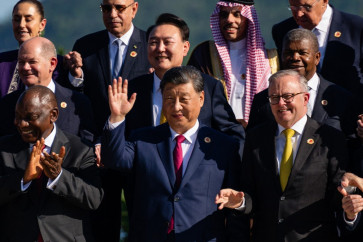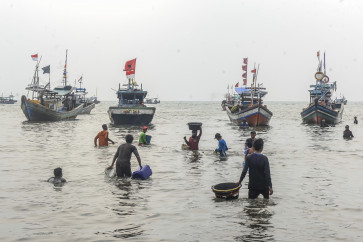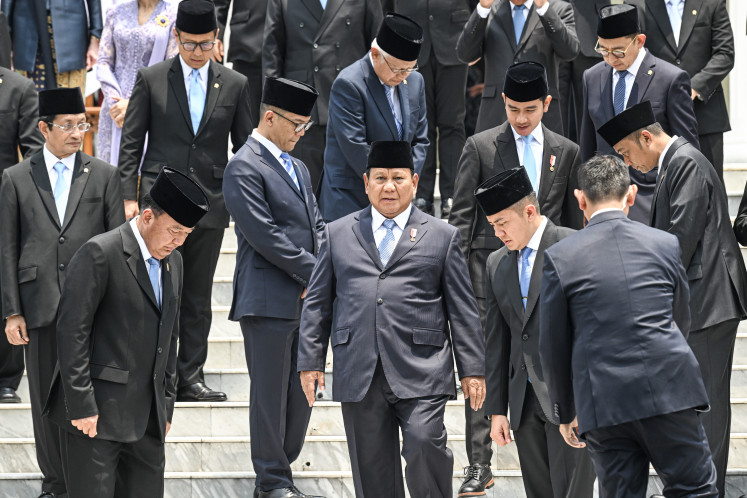Popular Reads
Top Results
Can't find what you're looking for?
View all search resultsPopular Reads
Top Results
Can't find what you're looking for?
View all search resultsWeaving the past into the future
If you stroll around the streets of Manado, North Sulawesi, you will be hard pressed to fi nd people wearing ethnic clothing
Change text size
Gift Premium Articles
to Anyone
I
f you stroll around the streets of Manado, North Sulawesi, you will be hard pressed to fi nd people wearing ethnic clothing.
They mostly wear batik, cotton shirts and jeans. Even most of the architectural designs of the houses are simple and modern, far from Manado’s traditional homes.
JP/P.J. Leo
Your search for the antique tenun (woven cloth) from Minahasa may end at the National Museum in Jakarta or at a museum in the Netherlands or maybe even with a private collector.
The traditional fabrics have become rarities as the provincial weaving tradition has faded away. Some people, however, are striving to revive the culture.
The North Sulawesi Culture and Art Institute (ISBSU) and PT Bilina Bina Cendikia (BBC), in cooperation with designer Thomas Sigar, have been reintroducing the lost treasure of Minahasa via fashion shows over the last two years. Their latest fashion show, “The Enchanting Culture of Minahasa”, featured 25 designs that used tenun and silk.
“We want to put Minahasa’s tenun into the limelight. The motifs, which are inspired by old pictures, scripts and sketches, are transferred into something that fi ts today’s conditions,” Thomas said.
The collections were divided into two chapters, with the fi rst comprising 13 women and men’s outfi ts made of silk and chiffon with patola motifs.
Patola, which means snake, became the highlight of the collection.
The motif was believed to have developed by a strong infl uence from Indian fabrics that were brought by traders from Gujarat. The horizontal and symmetrical motifs that resemble snake scales were used in a number of colors.
JP/P.J. Leo
The silhouette of women’s wear is djellabah, which uses drapery techniques. One of them is a long, sleeveless, white and dark brown ruffl e dress with some rhinestone accents on the straps.
Another dress used long red ropes wrapped around the chest and let loose from high around the waist, creating an elegant and charming wave when the model turned around.
The second chapter featured 12 outfi ts for men and women that used patola, pinawetengan, pinatikan and tembega motifs.
The men’s outfi ts were inspired by kurta (Indian long sleeved tunics), which were accented with long shawls. In the fi nal collections, Thomas played with more colors, although a certain tone of colors was still apparent in some outfits.
A girly, golden-toned, box-pleated short dress was accented with a single-shoulder bow tie strap. The short dress, festooned with beads on the chest, looked modern and ethnically charming at the same time.
Another short red dress had a low cut and pleats at the top. Thomas also combined long dresses with matching silk cloth that functioned as a background accent on the back.
“I try to visualize [the richness of Minahasa] wholeheartedly. I still feel that this is not perfect, but it is just a start,” he said.
He said he tried to put a modern touch on the motifs, shapes and materials because he wanted to let tenun Minahasa shine with its long-forgotten glory. Producing a thinner fabric, Thomas said, was another reason for catering to the current demands of people who often refused to wear thick clothes in the warm climate.
He said the fashion show was meant to inspire people to make the woven cloth chic again.
“We are going to hold a show in Bali, too, so we also gave a resort feel to the collections.
I made some open-shoulder evening dresses to give a taste of summer and the beach,” he said.
BBC head Lyarita W. Mawardi said the journey to revive tenun Minahasa started when her husband, Benny Mamoto, got a message from his father before he died.
His father told him that he would be happy if Benny could contribute something to Minahasa. Benny’s father came from Minahasa, while his mother came from Ngadirejo, Temanggung, Central Java.
After his father died, Benny and Lyarita went to North Sulawesi. The trip that was initially made without any particular intention other than a visit to his father’s hometown, turned out to change their lives.
Lyarita said they became very interested with Minahasa culture and were challenged with the current condition of the tradition, which was all but neglected by the younger generation.
“Many young people don’t continue the traditions such as learning the maengket dance,” she said.
When she visited a heritage site called watu pinawetengan [pinawetengan stone] in Pinabetengan village in Tompasu, she was impressed with the stone sketches. They later inspired one of the motifs.
Using weaving techniques from Bali, her company offered a weaving class to local people. Only 16 showed up, but she did not back down.
“I guess 16 people is a good start. I kept on telling them to produce fabric, although there were no real orders from customers, so they could keep practicing,” she said.
A number of traditional fabrics from remote areas in the country may have disappeared, defeated by the infl uence of modern textile making and simplicity brought by globalization. The future of the traditional fabrics, however, is not determined yet. People like Benny and Lyarita are weaving the future.











